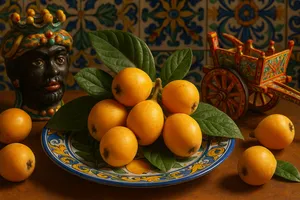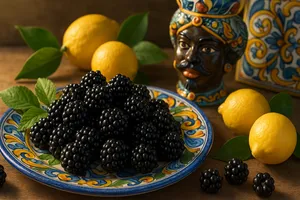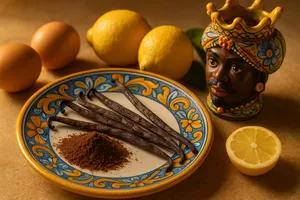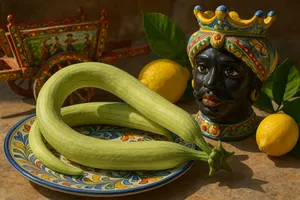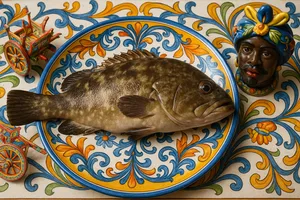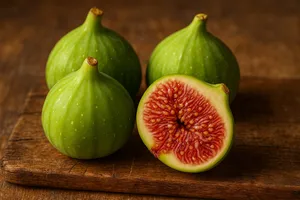Overview
Thyme is a perennial aromatic plant of the Lamiaceae (Labiate) family, native to the Mediterranean basin, characterised by small oval grey-green leaves, woody stems at the base, tiny pink-lilac flowers and an intense, aromatic, balsamic fragrance produced by essential oils rich in thymol. In Sicilian cooking, thyme is a traditional herb used to flavour meats (especially roast lamb, rabbit and pork), sauces, stews, grilled fish, baked vegetables and aromatic oils. It grows wild on Sicilian hills and mountains, where the dry Mediterranean climate and rocky soil favour its development. Wild Sicilian thyme has a particularly intense, distinctive aroma appreciated by connoisseurs.
Beyond culinary use, thyme has a long tradition as a medicinal plant: it has been used for infusions against coughs, colds and digestive problems, thanks to its antiseptic, expectorant and digestive properties. The ancient Egyptians used it for embalming; the Greeks burned it as incense in temples; the Romans used it to purify rooms. The name derives from the Greek “thymos” (courage, strength), perhaps because its fragrance was considered invigorating. In Sicilian rural culture, thyme was a respected plant, grown in kitchen gardens or gathered wild in the mountains, used both in cooking and as a household remedy. Its scent evokes Mediterranean scrubland, hot summers and the wisdom of robust plants thriving in harsh terrain yet offering intense flavours.
Characteristics
Thyme (mainly Thymus vulgaris, common thyme, though many species and varieties exist) forms small evergreen bushes 15–30 cm tall. The leaves are tiny (3–8 mm), oval-lanceolate, grey-green, leathery and aromatic. The stems are woody at the base and herbaceous on young growth. In spring and summer, thyme produces small pink-lilac flowers in spikes, much visited by bees (thyme honey is highly prized).
The fragrance is intense, aromatic, balsamic and slightly camphoraceous. The flavour is strong, slightly bitter, persistent, with spicy notes. Fresh leaves have a more delicate aroma, dried leaves a more concentrated one.
Fresh thyme has firm green leaves, flexible young stems and a strong aroma when rubbed. Older or poorly stored thyme has yellow or dark leaves and a weak or absent scent.
Varieties
Thymus vulgaris (common thyme)
The most widely used culinary variety, with grey-green leaves and a classic intense aroma. It is commercially grown and commonly used dried.
Thymus serpyllum (wild thyme or creeping thyme)
A creeping variety with smaller leaves and a slightly different, more delicate aroma. It grows wild in the mountains and is appreciated for wild harvesting.
Thymus citriodorus (lemon thyme)
A variety with a characteristic lemon fragrance and bright green leaves. Used for dishes where a citrus note is desired. Less traditional but interesting.
Thymus capitatus or Coridothymus capitatus (shrubby thyme)
A Mediterranean species with a very intense aroma, typical of Sicily and Greece. It has a more shrubby habit and small leaves. The Arabic “za’atar” blend often includes this species.
Cultivation
Thyme is a Mediterranean plant perfectly suited to the Sicilian climate. It grows well in full sun, in well-drained, poor or moderately fertile, rocky soil. It withstands extreme drought but does not tolerate stagnant water or overly damp soil. It can be propagated from seed, cuttings or by dividing the clump.
In Sicilian gardens, thyme is a very hardy perennial requiring minimal care: occasional watering only during prolonged drought and light pruning after flowering to maintain a compact shape. It can live many years (5–10 or more), producing aromatic leaves continuously.
Wild thyme grows spontaneously on Sicilian hills, mountains, rocky ground and scrublands. Wild harvesting is traditionally practised, with care taken not to uproot the plant—only upper sprigs are cut.
Seasonality
Fresh thyme is available year-round in mild climates such as Sicily, where the plant is evergreen. The best time for harvesting is just before flowering (spring), when the leaves are richest in essential oils. Growth slows in winter but the leaves remain available.
Use in Sicilian cooking
Flavouring roasts
Thyme is a classic herb for flavouring roasted meats: lamb, kid, rabbit, pork and chicken. Fresh sprigs are inserted into the meat during cooking or added to the pan. Thyme’s intense fragrance enhances the flavour of the meat.
Sauces and stews
Leaves or sprigs of thyme flavour meat sauces, ragù, stews and braises. They are added during long cooking, gradually releasing their aroma. They may be removed before serving or left as decoration.
Grilled fish
Sprigs of thyme are placed on whole fish during grilling or added to the embers to perfume the fish with aromatic smoke. Thyme pairs well with flavourful fish (mackerel, sardines, sea bream).
Baked vegetables
Potatoes, courgettes, aubergines, peppers and tomatoes baked in the oven are flavoured with fresh thyme, oil and garlic. Thyme gives them a characteristic Mediterranean aroma.
Aromatic oils and vinegars
Fresh thyme sprigs infused in extra-virgin olive oil or vinegar create aromatic condiments for salads, vegetables and meats. They are left to macerate for several weeks.
Breads and focaccias
Thyme leaves can be incorporated into bread or focaccia dough, or sprinkled on the surface before baking to add fragrance.
Digestive infusion
Traditionally, fresh or dried thyme leaves are used to prepare digestive, calming and expectorant infusions. This is a herbal as well as a culinary use.
Fresh vs dried thyme
Fresh thyme: Has a more delicate, fresh aroma and is ideal for preparations where the sprigs remain visible (roasts, grilled fish). It keeps for only a few days in the refrigerator.
Dried thyme: Has a more concentrated, intense aroma (drying concentrates the essential oils). It is used in smaller amounts (one-third of fresh). It keeps for months in a closed jar and is practical for everyday use.
When substituting dried for fresh thyme: 1 tablespoon of fresh thyme = 1 teaspoon of dried thyme.
Storage
Fresh thyme keeps in the refrigerator, wrapped in slightly damp kitchen paper or in a perforated bag, for 5–7 days. It should not be washed before storing (moisture accelerates deterioration); wash only before use.
To dry thyme: gather sprigs, tie them together and hang them upside down in a dry, ventilated, shaded place. After 1–2 weeks the leaves will be dry. Strip them from the stems (rubbing gently), and store in closed glass jars, in the dark, for 6–12 months.
Thyme leaves can be frozen: washed, dried and stored in bags or frozen in ice cubes with oil. They keep for months but lose some aroma.
Tips for buying
When buying fresh thyme (in bunches), choose sprigs with bright green, firm leaves, without dry or yellow parts or mould. Avoid wilted thyme with a weak scent.
The aroma should be intense: rubbing leaves lightly between the fingers should release a strong, immediate fragrance. If thyme has little scent, it is old or of poor quality.
It is preferable to buy potted plants for home growing: having fresh thyme at hand is invaluable. One plant provides leaves for years with minimal care.
Quality dried thyme has green leaves (not brown), an intense fragrance and airtight packaging that preserves aroma.
Medicinal properties
Thyme is rich in essential oils (mainly thymol and carvacrol), flavonoids, phenolic acids and tannins. It has antiseptic (thymol is a powerful disinfectant), antibacterial, antifungal, antiviral, expectorant, antispasmodic, digestive and antioxidant properties.
In Sicilian (and Mediterranean) folk tradition, thyme was used for:
Infusions for coughs and colds: The expectorant effect helps loosen mucus, while the antiseptic action combats respiratory infections.
Digestive infusions: After heavy meals, to soothe the stomach and aid digestion.
Gargles: For sore throat and mouth inflammation (antiseptic properties).
Steam inhalations: Thyme vapour used to decongest the airways.
Baths: Bathwater fragranced with thyme for a toning effect on the skin.
Caution: pure thyme essential oil is very concentrated and may be irritating. It must be used diluted and with care. Normal culinary use is safe.
Thyme in Mediterranean tradition
Thyme was sacred to ancient Mediterranean civilisations. The Egyptians used it for embalming (its antiseptic properties preserve). The Greeks burned thyme as incense in temples for purification, its scent pleasing to the gods. Roman soldiers bathed in thyme-scented water before battle to gain courage (thymos = courage).
In the Middle Ages, ladies gave knights handkerchiefs embroidered with thyme sprigs as a symbol of courage. Thyme was planted on burial mounds to honour the dead and ease their passage to the afterlife.
Thyme has always had a dual nature: culinary herb and medicinal/magical plant. This duality has survived to the present day.
Curiosities
Thyme honey is among the most prized: it has a dark amber colour, dense consistency and intense aromatic flavour. It is produced mainly in Sicily, Greece and other Mediterranean areas where thyme grows abundantly. Bees visit thyme flowers eagerly.
In the language of flowers, thyme symbolises courage, activity and energy. It was given as a wish for strength and determination.
Thyme attracts bees, butterflies and pollinating insects: cultivating it in gardens promotes biodiversity. It is an excellent melliferous plant.
In some Sicilian folk traditions, thyme sprigs were burned to purify rooms, ward off negative energies and perfume the home—a practice linked to its aromatic properties and reputation as a protective plant.
Thyme is one of the herbs that make up the French “bouquet garni” (a bundle of herbs—thyme, bay leaf, parsley—tied together and used to flavour broths, soups and sauces). It is a staple of classic cuisine.
An old Mediterranean proverb says: “Where thyme grows, the air is healthy,” referring to the plant’s purifying and antiseptic qualities. Areas rich in thyme were considered wholesome.
Thymol, the active principle in thyme, is used in pharmacology and cosmetics for its disinfectant properties. It is found in mouthwashes, toothpastes and hygiene products.
The thyme plant is xerophilous (adapted to drought): its small, leathery leaves, covered with fine hairs, reduce water loss through evaporation. It is a perfect example of evolutionary adaptation to the dry, hot Mediterranean climate.




